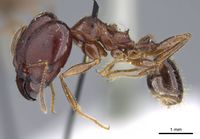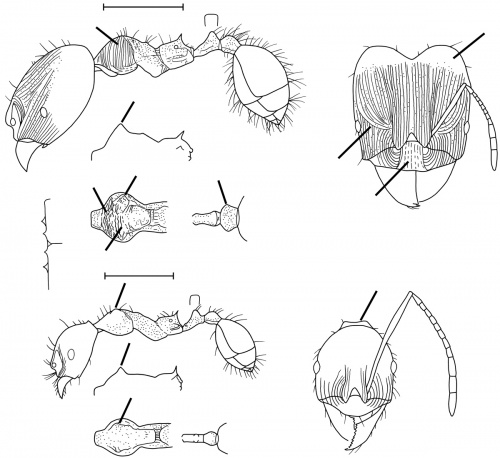Pheidole gibba
| Pheidole gibba | |
|---|---|

| |
| Scientific classification | |
| Kingdom: | Animalia |
| Phylum: | Arthropoda |
| Class: | Insecta |
| Order: | Hymenoptera |
| Family: | Formicidae |
| Subfamily: | Myrmicinae |
| Tribe: | Attini |
| Genus: | Pheidole |
| Species: | P. gibba |
| Binomial name | |
| Pheidole gibba Mayr, 1887 | |
| Synonyms | |
| |
Nothing is known about the biology of gibba.
Identification
See the description in the nomenclature section.
Keys including this Species
Distribution
Rio de Janeiro and Santa Catarina states, Brazil. (Wilson 2003)
Distribution based on Regional Taxon Lists
Neotropical Region: Brazil (type locality).
Distribution based on AntMaps
Distribution based on AntWeb specimens
Check data from AntWeb
Countries Occupied
| Number of countries occupied by this species based on AntWiki Regional Taxon Lists. In general, fewer countries occupied indicates a narrower range, while more countries indicates a more widespread species. |

|
Estimated Abundance
| Relative abundance based on number of AntMaps records per species (this species within the purple bar). Fewer records (to the left) indicates a less abundant/encountered species while more records (to the right) indicates more abundant/encountered species. |

|
Biology
Association with Other Organisms
 Explore: Show all Associate data or Search these data. See also a list of all data tables or learn how data is managed.
Explore: Show all Associate data or Search these data. See also a list of all data tables or learn how data is managed.
This species is a host for the eucharitid wasp Orasema chunpi (a parasite) in Brazil (Silva & Casadei-Ferreira, 2020).
Castes
Images from AntWeb
   
| |
| Worker. Specimen code casent0919777. Photographer Z. Lieberman, uploaded by California Academy of Sciences. | Owned by NHMW, Vienna, Austria. |
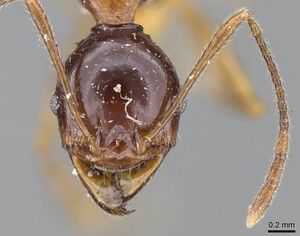 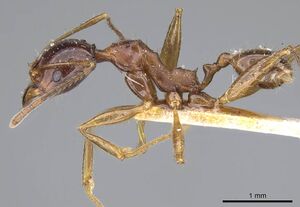  
| |
| Syntype of Pheidole gibba. Worker. Specimen code casent0919779. Photographer Z. Lieberman, uploaded by California Academy of Sciences. | Owned by NHMW, Vienna, Austria. |
   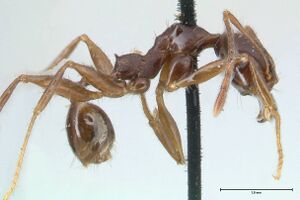
| |
| Type of Pheidole gibba. Worker. Specimen code focol1545. Photographer Christiana Klingenberg, uploaded by California Academy of Sciences. | Owned by ZMHB, Berlin, Germany. |
Nomenclature
The following information is derived from Barry Bolton's Online Catalogue of the Ants of the World.
- gibba. Pheidole gibba Mayr, 1887: 590 (s.), 604 (w.) BRAZIL. Senior synonym of lopesi: Kempf, 1972b: 455. See also: Wilson, 2003: 695.
- lopesi. Pheidole gibba var. lopesi Borgmeier, 1937b: 233 (s.w.) BRAZIL. Junior synonym of gibba: Kempf, 1972b: 455.
Unless otherwise noted the text for the remainder of this section is reported from the publication that includes the original description.
Description
From Wilson (2003): DIAGNOSIS Very distinctive within Pheidole as a whole.
Major: large; slender; humeri very prominent, subangulate, each forming a large equilateral triangle in dorsal-oblique view; pronotum with transversely rugulose dorsum and vertically carinulate sides; all of dorsal surface of head carinulate except occiput and frontal triangle, which are smooth; carinulae that originate from posterior half of sides of frontal lobes curve laterally and then posteriorly; postpetiole diamond-shaped from above.
Minor: humeri as in major (q.v.); all of mesosomal dorsum foveolate; occiput narrowed, with nuchal collar.
MEASUREMENTS (mm) Lectotype major: HW 1.96, HL 2.10, SL 1.22, EL 0.24, PW 0.98. Paralectotype minor: HW 0.84, HL 1.00, SL 1.12, EL 0.18, PW 0.58.
COLOR Major: concolorous medium reddish brown.
Minor: body light reddish brown, appendages brownish yellow.
Figure. Upper: lectotype, major. Lower: paralectotype, minor. Scale bars = 1 mm.
Type Material
BRAZIL: Santa Catarina. Naturhistorisches Museum Wien, Vienna - as reported in Wilson (2003)
Etymology
L gibba, humpbacked, referring to the extended humeri. (Wilson 2003)
References
- Wilson, E. O. 2003. Pheidole in the New World: A dominant, hyperdiverse ant genus. Harvard University Press, Cambridge, MA. (page 695, fig. major, minor described)
- Albuquerque, E., Prado, L., Andrade-Silva, J., Siqueira, E., Sampaio, K., Alves, D., Brandão, C., Andrade, P., Feitosa, R., Koch, E., Delabie, J., Fernandes, I., Baccaro, F., Souza, J., Almeida, R., Silva, R. 2021. Ants of the State of Pará, Brazil: a historical and comprehensive dataset of a key biodiversity hotspot in the Amazon Basin. Zootaxa 5001, 1–83 (doi:10.11646/zootaxa.5001.1.1).
- Kempf, W. W. 1972d. A study of some Neotropical ants of genus Pheidole Westwood. I. (Hymenoptera: Formicidae). Stud. Entomol. 15: 449-464 (page 455, senior synonym of lopesi)
- Mayr, G. 1887. Südamerikanische Formiciden. Verh. K-K. Zool.-Bot. Ges. Wien 37: 511-632 (page 590, 604, soldier described, worker described)
- Silva, T.S.R., Casadei-Ferreira, A. 2020. A species-level association in Pheidole Westwood (Hymenoptera: Formicidae) ants with a parasitoid wasp of the genus Orasema Cameron (Hymenoptera: Eucharitidae) in Brazil. Revista Brasileira de Entomologia 64(2), e20200005 (doi:10.1590/1806-9665-RBENT-2020-0005).
- Silva, T.S.R., Casadei-Ferreira, A. 2020. A species-level association in Pheidole Westwood (Hymenoptera: Formicidae) ants with a parasitoid wasp of the genus Orasema Cameron (Hymenoptera: Eucharitidae) in Brazil. Revista Brasileira de Entomologia 64(2):e20200005 (doi:10.1590/1806-9665-RBENT-2020-0005).
References based on Global Ant Biodiversity Informatics
- Kempf W. W. 1972. A study of some Neotropical ants of genus Pheidole Westwood. I. (Hymenoptera: Formicidae). Studia Entomologica 15: 449-464.
- Kempf W. W. 1978. A preliminary zoogeographical analysis of a regional ant fauna in Latin America. 114. Studia Entomologica 20: 43-62.
- Kempf, W.W. 1972. Catalago abreviado das formigas da regiao Neotropical (Hym. Formicidae) Studia Entomologica 15(1-4).
- Rosa da Silva R. 1999. Formigas (Hymenoptera: Formicidae) do oeste de Santa Catarina: historico das coletas e lista atualizada das especies do Estado de Santa Catarina. Biotemas 12(2): 75-100.
